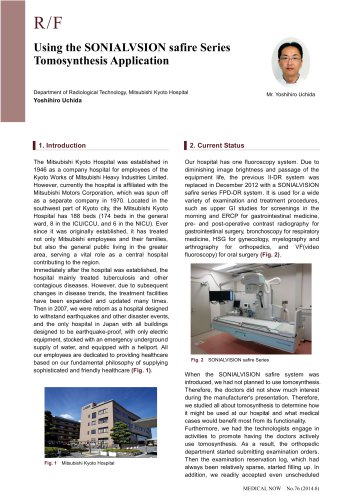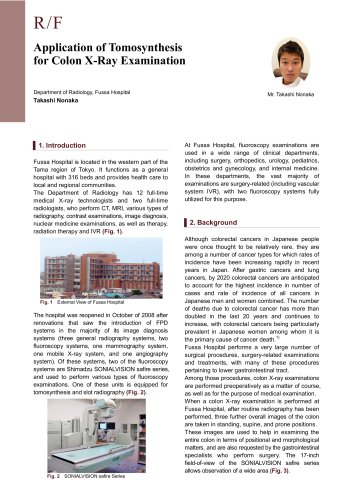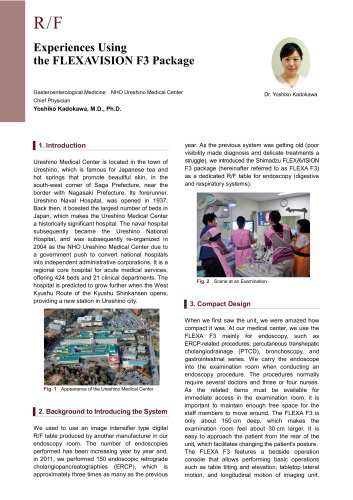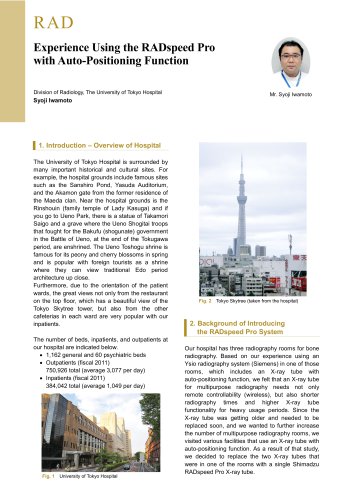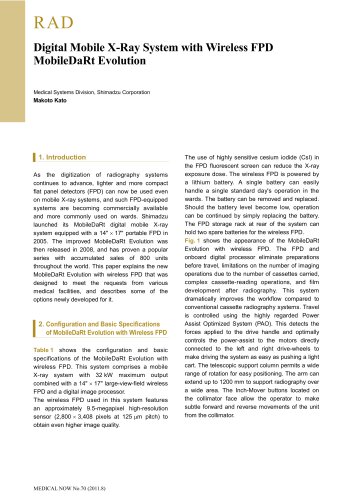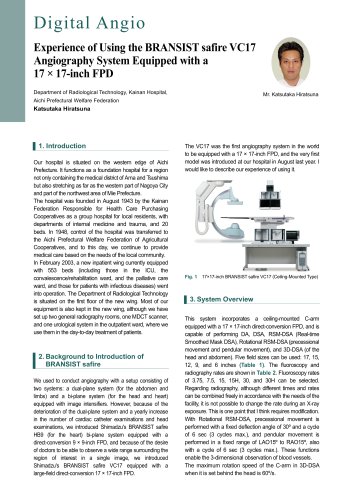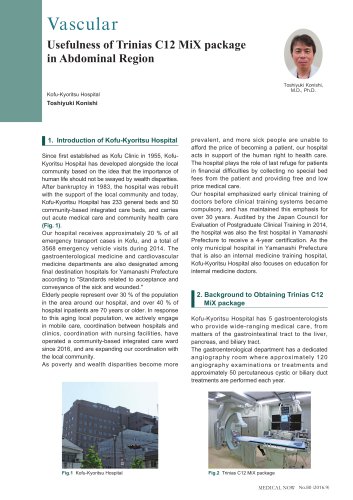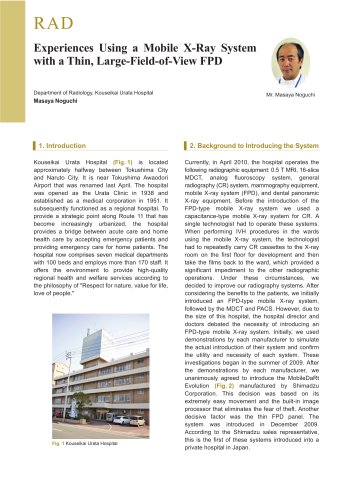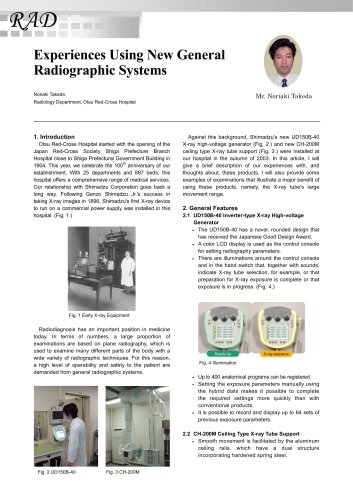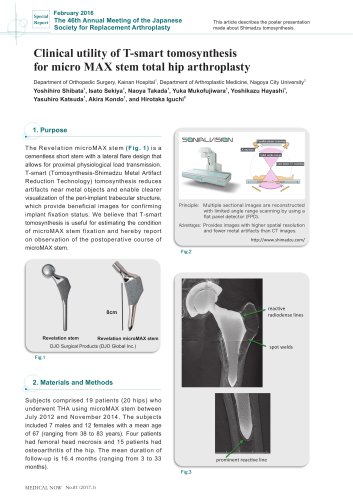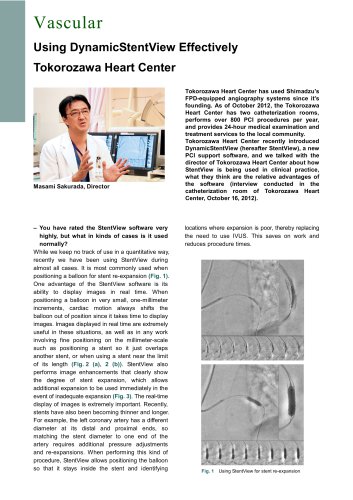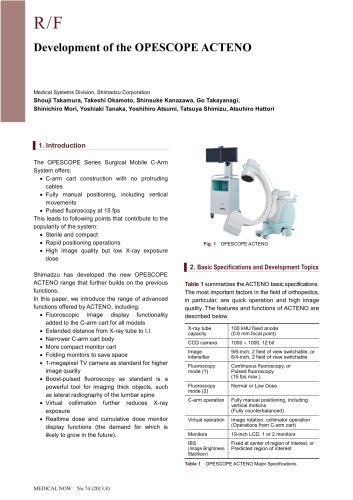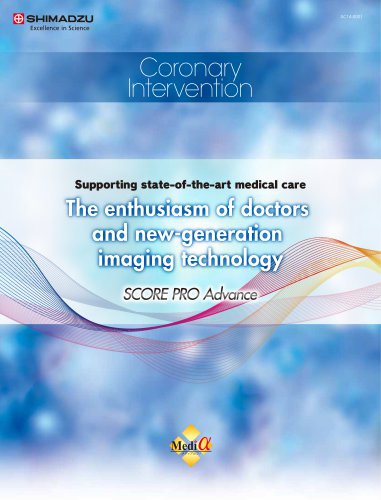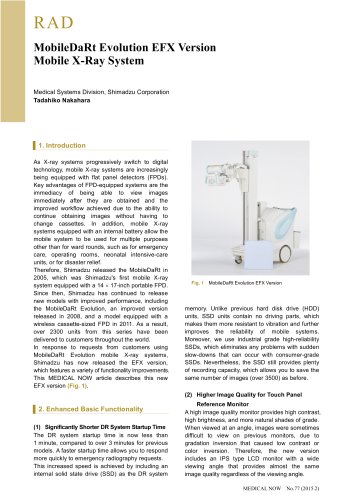
Catalog excerpts
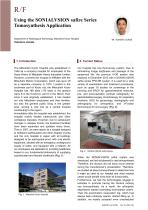
R/F Using the SONIALVSION safire Series Tomosynthesis Application Department of Radiological Technology, Mitsubishi Kyoto Hospital Yoshihiro Uchida 1. Introduction The Mitsubishi Kyoto Hospital was established in 1946 as a company hospital for employees of the Kyoto Works of Mitsubishi Heavy Industries Limited. However, currently the hospital is affiliated with the Mitsubishi Motors Corporation, which was spun off as a separate company in 1970. Located in the southwest part of Kyoto city, the Mitsubishi Kyoto Hospital has 188 beds (174 beds in the general ward, 8 in the ICU/CCU, and 6 in the NICU). Ever since it was originally established, it has treated not only Mitsubishi employees and their families, but also the general public living in the greater area, serving a vital role as a central hospital contributing to the region. Immediately after the hospital was established, the hospital mainly treated tuberculosis and other contagious diseases. However, due to subsequent changes in disease trends, the treatment facilities have been expanded and updated many times. Then in 2007, we were reborn as a hospital designed to withstand earthquakes and other disaster events, and the only hospital in Japan with all buildings designed to be earthquake-proof, with only electric equipment, stocked with an emergency underground supply of water, and equipped with a heliport. All our employees are dedicated to providing healthcare based on our fundamental philosophy of supplying sophisticated and friendly healthcare (Fig. 1). Fig. 1 Mitsubishi Kyoto Hospital 2. Current Status Our hospital has one fluoroscopy system. Due to diminishing image brightness and passage of the equipment life, the previous II-DR system was replaced in December 2012 with a SONIALVISION safire series FPD-DR system. It is used for a wide variety of examination and treatment procedures, such as upper GI studies for screenings in the morning and ERCP for gastrointestinal medicine, pre- and post-operative contrast radiography for gastrointestinal surgery, bronchoscopy for respiratory medicine, HSG for gynecology, myelography and arthrography for orthopedics, and VF(video fluoroscopy) for oral surgery (Fig. 2). Fig. 2 SONIALVISION safire Series When the SONIALVISION safire system was introduced, we had not planned to use tomosynthesis. Therefore, the doctors did not show much interest during the manufacturer's presentation. Therefore, we studied all about tomosynthesis to determine how it might be used at our hospital and what medical cases would benefit most from its functionality. Furthermore, we had the technologists engage in activities to promote having the doctors actively use tomosynthesis. As a result, the orthopedic department started submitting examination orders. Then the examination reservation log, which had always been relatively sparse, started filling up. In addition, we readily accepted even unscheduled MEDICAL NOW No.76 (2014.8)
Open the catalog to page 1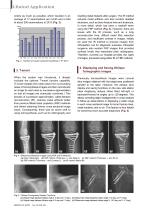
orders as much as possible, which resulted in an average of 17 examinations per month and a total of about 200 examinations in 2013 (Fig. 3). inserting metal implants after surgery. The IR method reduces metal artifacts and also renders detailed structures, such as bone fracture lines and trabecula, in more detail, which has been a tradeoff when using the FBP method (Fig. 4). However, there are issues with the IR process, such as a long reconstruction time, difficult metal filter selection process, and insufficient contrast in images. Initially we used the IR method to process images from...
Open the catalog to page 2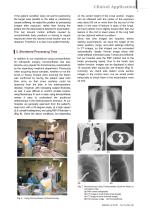
If the patient condition does not permit positioning the target area parallel to the table or positioning causes suffering, we adjust the position by processing images after exposure, rather than forcing the patient into the ideal posture desired for examination. This can prevent motion artifacts caused by uncomfortable body positions or having to repeat exposures when the desired cross section was not obtained. Therefore, it is also more patient-friendly. 5. Shortened Processing Time In addition to our experience using tomosynthesis for orthopedic surgery, tomosynthesis has also become...
Open the catalog to page 3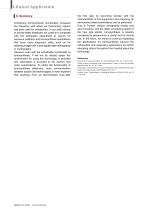
6. Summary Introducing tomosynthesis functionality increased the frequency with which our fluoroscopy system has been used for orthopedics. In our daily striving to provide better healthcare, we continue to cooperate with the orthopedic department to search for exposure positions and tomosynthesis applications that have more diagnostic utility, such as for obtaining images with a load applied after arthrography or myelography. However, even with the remarkable functionality of tomosynthesis, it will not be utilized unless the environment for using this technology is provided and information...
Open the catalog to page 4Archived catalogs
-
Tomosynthesis
6 Pages
-
FLEXAVISION F3
3 Pages
-
RADSpeed Pro
4 Pages
-
DynamicStentView
4 Pages
-
X-Ray System
3 Pages
-
Digital Angio
4 Pages
-
c12 MIX
4 Pages
-
RAD
4 Pages
-
t-smart
2 Pages
-
Vascular_interview
3 Pages
-
CT-like
3 Pages
-
OPESCOPE ACTENO
3 Pages

